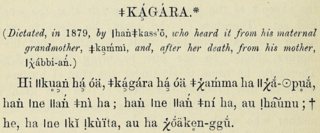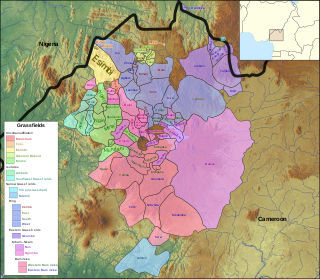Related Research Articles
In articulatory phonetics, a consonant is a speech sound that is articulated with complete or partial closure of the vocal tract. Examples are and [b], pronounced with the lips; and [d], pronounced with the front of the tongue; and [g], pronounced with the back of the tongue;, pronounced in the throat;, [v], and, pronounced by forcing air through a narrow channel (fricatives); and and, which have air flowing through the nose (nasals). Contrasting with consonants are vowels.

The International Phonetic Alphabet (IPA) is an alphabetic system of phonetic notation based primarily on the Latin script. It was devised by the International Phonetic Association in the late 19th century as a standardized representation of speech sounds in written form. The IPA is used by lexicographers, foreign language students and teachers, linguists, speech–language pathologists, singers, actors, constructed language creators, and translators.
A macron is a diacritical mark: it is a straight bar ¯ placed above a letter, usually a vowel. Its name derives from Ancient Greek μακρόν (makrón) "long", since it was originally used to mark long or heavy syllables in Greco-Roman metrics. It now more often marks a long vowel. In the International Phonetic Alphabet, the macron is used to indicate a mid-tone; the sign for a long vowel is instead a modified triangular colon ⟨ː⟩.

The Standard Alphabet is a Latin-script alphabet developed by Karl Richard Lepsius. Lepsius initially used it to transcribe Egyptian hieroglyphs in his Denkmäler aus Ägypten und Äthiopien and extended it to write African languages, published in 1854 and 1855, and in a revised edition in 1863. The alphabet was comprehensive but was not used much as it contained a lot of diacritic marks and was difficult to read and typeset at that time. It was, however, influential in later projects such as Ellis's Paleotype, and diacritics such as the acute accent for palatalization, under-dot for retroflex, underline for Arabic emphatics, and the click letters continue in modern use.
A vowel is a syllabic speech sound pronounced without any stricture in the vocal tract. Vowels are one of the two principal classes of speech sounds, the other being the consonant. Vowels vary in quality, in loudness and also in quantity (length). They are usually voiced and are closely involved in prosodic variation such as tone, intonation and stress.
The Thai script is the abugida used to write Thai, Southern Thai and many other languages spoken in Thailand. The Thai alphabet itself has 44 consonant symbols, 16 vowel symbols that combine into at least 32 vowel forms and four tone diacritics to create characters mostly representing syllables.

Malayalam script is a Brahmic script used commonly to write Malayalam, which is the principal language of Kerala, India, spoken by 45 million people in the world. It is a Dravidian language spoken in the Indian state of Kerala and the union territories of Lakshadweep and Puducherry by the Malayali people. It is one of 22 scheduled languages of India Malayalam script is also widely used for writing Sanskrit texts in Kerala.
The Burmese alphabet is an abugida used for writing Burmese. It is ultimately adapted from a Brahmic script, either the Kadamba or Pallava alphabet of South India. The Burmese alphabet is also used for the liturgical languages of Pali and Sanskrit. In recent decades, other, related alphabets, such as Shan and modern Mon, have been restructured according to the standard of the Burmese alphabet

A digraph or digram is a pair of characters used in the orthography of a language to write either a single phoneme, or a sequence of phonemes that does not correspond to the normal values of the two characters combined.

Venda or Tshivenda is a Bantu language and an official language of South Africa. It is mainly spoken by the Venda people in the northern part of South Africa's Limpopo province, as well as by some Lemba people in South Africa. The Venda language is related to Kalanga, which is spoken in Zimbabwe and Botswana. During the apartheid era of South Africa, the bantustan of Venda was set up to cover the Venda speakers of South Africa.

The Mandinka language or Mandingo, is a Mande language spoken by the Mandinka people of Guinea, northern Guinea-Bissau, the Casamance region of Senegal, and in The Gambia where it is one of the principal languages.

The International Phonetic Alphabet was created soon after the International Phonetic Association was established in the late 19th century. It was intended as an international system of phonetic transcription for oral languages, originally for pedagogical purposes. The Association was established in Paris in 1886 by French and British language teachers led by Paul Passy. The prototype of the alphabet appeared in Phonetic Teachers' Association (1888b). The Association based their alphabet upon the Romic alphabet of Henry Sweet, which in turn was based on the Phonotypic Alphabet of Isaac Pitman and the Palæotype of Alexander John Ellis.
Modern Literal Taiwanese (MLT), also known as Modern Taiwanese Language (MTL), is an orthography in the Latin alphabet for Taiwanese based on the Taiwanese Modern Spelling System (TMSS). MLT is able to use the ASCII character set to indicate the proper variation of pitch without any subsidiary scripts or diacritic symbols.
The Romic Alphabet, sometimes known as the Romic Reform, is a phonetic alphabet proposed by Henry Sweet. It descends from Ellis's Palaeotype alphabet and English Phonotypic Alphabet, and is the direct ancestor of the International Phonetic Alphabet. In Romic every sound had a dedicated symbol, and every symbol represented a single sound. There were no capital letters; there were letters derived from small capitals, though these were distinct letters.
The General Alphabet of Cameroon Languages is an orthographic system created in the late 1970s for all Cameroonian languages. Consonant and vowel letters are not to contain diacritics, though ⟨ẅ⟩ is a temporary exception. The alphabet is not used sufficiently for the one unique letter, a bilabial trill, to have been added to Unicode.
Yɛmba or Yemba, also Yémba or Bamiléké Dschang, is a major Bamileke language of Cameroon. It was spoken by 300,000 or so people in the West Region in 1992.

Babanki, or Kejom, is the traditional language of the Kejom people of the Western Highlands of Cameroon.

The Tai Viet script is a Brahmic script used by the Tai Dam people and various other Thai people in Vietnam and Thailand.
References
- ↑ Awing at Ethnologue (18th ed., 2015) (subscription required)